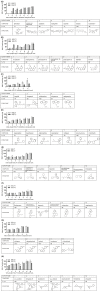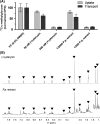Novel natural and synthetic inhibitors of solute carriers SGLT1 and SGLT2
- PMID: 31384471
- PMCID: PMC6664820
- DOI: 10.1002/prp2.504
Novel natural and synthetic inhibitors of solute carriers SGLT1 and SGLT2
Abstract
Selective analogs of the natural glycoside phloridzin are marketed drugs that reduce hyperglycemia in diabetes by inhibiting the active sodium glucose cotransporter SGLT2 in the kidneys. In addition, intestinal SGLT1 is now recognized as a target for glycemic control. To expand available type 2 diabetes remedies, we aimed to find novel SGLT1 inhibitors beyond the chemical space of glycosides. We screened a bioactive compound library for SGLT1 inhibitors and tested primary hits and additional structurally similar molecules on SGLT1 and SGLT2 (SGLT1/2). Novel SGLT1/2 inhibitors were discovered in separate chemical clusters of natural and synthetic compounds. These have IC50-values in the 10-100 μmol/L range. The most potent identified novel inhibitors from different chemical clusters are (SGLT1-IC50 Mean ± SD, SGLT2-IC50 Mean ± SD): (+)-pteryxin (12 ± 2 μmol/L, 9 ± 4 μmol/L), (+)-ε-viniferin (58 ± 18 μmol/L, 110 μmol/L), quinidine (62 μmol/L, 56 μmol/L), cloperastine (9 ± 3 μmol/L, 9 ± 7 μmol/L), bepridil (10 ± 5 μmol/L, 14 ± 12 μmol/L), trihexyphenidyl (12 ± 1 μmol/L, 20 ± 13 μmol/L) and bupivacaine (23 ± 14 μmol/L, 43 ± 29 μmol/L). The discovered natural inhibitors may be further investigated as new potential (prophylactic) agents for controlling dietary glucose uptake. The new diverse structure activity data can provide a starting point for the optimization of novel SGLT1/2 inhibitors and support the development of virtual SGLT1/2 inhibitor screening models.
Keywords: SGLT1; SGLT2; diabetes; glucose; inhibitors; screening.
Conflict of interest statement
None.
Figures



Similar articles
-
Intestinal Sodium Glucose Cotransporter 1 Inhibition Enhances Glucagon-Like Peptide-1 Secretion in Normal and Diabetic Rodents.J Pharmacol Exp Ther. 2015 Sep;354(3):279-89. doi: 10.1124/jpet.115.225508. Epub 2015 Jun 23. J Pharmacol Exp Ther. 2015. PMID: 26105952
-
Development of a novel non-radioactive cell-based method for the screening of SGLT1 and SGLT2 inhibitors using 1-NBDG.Mol Biosyst. 2013 Aug;9(8):2010-20. doi: 10.1039/c3mb70060g. Epub 2013 May 8. Mol Biosyst. 2013. PMID: 23657801
-
Development of SGLT1 and SGLT2 inhibitors.Diabetologia. 2018 Oct;61(10):2079-2086. doi: 10.1007/s00125-018-4654-7. Epub 2018 Aug 22. Diabetologia. 2018. PMID: 30132033 Free PMC article. Review.
-
N-Indolylglycosides bearing modifications at the glucose C6-position as sodium-dependent glucose co-transporter 2 inhibitors.Bioorg Med Chem. 2016 May 15;24(10):2242-50. doi: 10.1016/j.bmc.2016.03.058. Epub 2016 Mar 30. Bioorg Med Chem. 2016. PMID: 27075813
-
Natural Products as Lead Compounds for Sodium Glucose Cotransporter (SGLT) Inhibitors.Planta Med. 2017 Aug;83(12-13):985-993. doi: 10.1055/s-0043-106050. Epub 2017 Apr 10. Planta Med. 2017. PMID: 28395363 Review.
Cited by
-
The antitussive cloperastine improves breathing abnormalities in a Rett Syndrome mouse model by blocking presynaptic GIRK channels and enhancing GABA release.Neuropharmacology. 2020 Oct 1;176:108214. doi: 10.1016/j.neuropharm.2020.108214. Epub 2020 Jul 3. Neuropharmacology. 2020. PMID: 32622786 Free PMC article.
-
Biocomputational Prediction Approach Targeting FimH by Natural SGLT2 Inhibitors: A Possible Way to Overcome the Uropathogenic Effect of SGLT2 Inhibitor Drugs.Molecules. 2021 Jan 22;26(3):582. doi: 10.3390/molecules26030582. Molecules. 2021. PMID: 33499241 Free PMC article.
-
Chemistry, Biosynthesis and Pharmacology of Viniferin: Potential Resveratrol-Derived Molecules for New Drug Discovery, Development and Therapy.Molecules. 2022 Aug 9;27(16):5072. doi: 10.3390/molecules27165072. Molecules. 2022. PMID: 36014304 Free PMC article. Review.
-
A Review of Coumarins and Coumarin-Related Compounds for Their Potential Antidiabetic Effect.Clin Med Insights Endocrinol Diabetes. 2021 Sep 14;14:11795514211042023. doi: 10.1177/11795514211042023. eCollection 2021. Clin Med Insights Endocrinol Diabetes. 2021. PMID: 35173509 Free PMC article. Review.
-
A comprehensive in-vitro/in-vivo screening toolbox for the elucidation of glucose homeostasis modulating properties of plant extracts (from roots) and its bioactives.Front Pharmacol. 2024 Jun 26;15:1396292. doi: 10.3389/fphar.2024.1396292. eCollection 2024. Front Pharmacol. 2024. PMID: 38989154 Free PMC article. Review.
References
-
- Zheng Y, Ley SH, Hu FB. Global aetiology and epidemiology of type 2 diabetes mellitus and its complications. Nat Rev Endocrinol. 2018;14(2):88‐98. - PubMed
-
- Madaan T, Akhtar M, Najmi AK. Sodium glucose CoTransporter 2 (SGLT2) inhibitors: Current status and future perspective. Eur J Pharm Sci. 2016;93:244‐252. - PubMed
-
- Oyer DS. The science of hypoglycemia in patients with diabetes. Curr Diabetes Rev. 2013;9(3):195‐208. - PubMed
-
- Tahrani AA, Barnett AH, Bailey CJ. SGLT inhibitors in management of diabetes. Lancet Diabetes Endocrinol. 2013;1(2):140‐151. - PubMed
Publication types
MeSH terms
Substances
LinkOut - more resources
Full Text Sources
Medical

